March 2019
Honoring Yesterday – Protecting Tomorrow
Vol. 50, No. 3
What’s Inside
- President’s Message
- Pensions Heavily Benefit the Economy
- RESDC Scholarship History
- Recent Events
- Bits and Pieces
- How to Check Your Credit Score
- Online Services
- CRCEA Spring 2019 Conference
- March Recruitment Mania
- Pension Facts at a Glance
- Board Member Profile, Charles Morgan
- Members Share: My New Zealand Experience
- Welcome New Members
March Calendar of Events
Sun., Mar 10
Daylight Savings Time Begins
Thurs., Mar 14, 9:30am
RESDC Board of Directors Meeting
8825 Aero Drive, Suite 205
Thurs., Mar 21, 9:00am
SDCERA Board of Retirement Meeting
2275 Rio Bonito Way, Suite 200
![]() View the NETWORK
View the NETWORK
as a printable PDF
Are you on social media?
Stay connected with us!![]()
![]()
![]()
Quote of the Month
“Perfection is not attainable, but if we chase perfection we can catch excellence.”
▪ Vince Lombardi
President’s Message
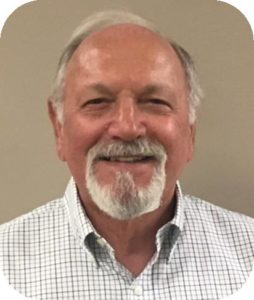
By John J. McTighe
Thanks to all RESDC members who invited friends to join RESDC during “Fellowship February.” An organization like ours must continually attract new members. To that end, Executive Director Mark Nanzer and I make a brief presentation at all the SDCERA retirement seminars to encourage those county employees who are on the verge of retirement to sign up for RESDC membership. (See Chuck Brown’s article for other recruitment information.)
I was pleased to see a number of our members from north county at the February General Membership meeting held at the North Inland Live Well Center on February 20th. We purposely move our General Membership meetings around the county so it’s convenient for our members to attend at least one meeting a year in their part of the county. It was also great seeing so many people at the theatre outing at The Old Globe to see Familiar by Danai Gurira on Sunday, February 24th. This was the first year we tried a matinee performance and from the great turnout, we will do so again in the future. The show was terrific, a mix of family drama and comedy that many of us could see happen in our own families.
In early February, my wife and I had planned to go out of town to celebrate a birthday milestone. But, when the weather turned bad all over the country, we decided to stay home and have a low-key celebration right here in San Diego County. On the day of her birthday, we ventured down to Balboa Park and took advantage of the Rueben Fleet Science Center’s first Monday of the month senior discount and saw an interesting iMax movie. We then strolled around the park and spent some time in the lovely Botanical Building. We marveled at how fortunate we are here in San Diego to have the civic centerpiece of our city be beautiful Balboa Park. So later I spent some time researching the history of Balboa Park.
The park started as “City Park” back in 1868 when San Diego civic leaders set aside 1400 acres of land (today the park is 1200 acres). By comparison, New York City’s Central Park is only 846 acres. It was more than 20 years later that any formal landscaping and development began to take place. Kate Sessions, a name many San Diegans have heard, offered in 1892 to plant 100 trees a year in the park in exchange for 32 acres being set aside for her commercial nursery. She was later honored with the title “Mother of Balboa Park” at the 1935 California Pacific International Exposition. Recently, the Balboa Park Conservancy sponsored a one-day planting of 500 trees which will add to what are now approximately 15,000 trees that populate the park.
All that we now enjoy as Balboa Park didn’t happen overnight. The first master plan guided early park improvements and beautification efforts between 1903 and 1910. Much of that work was funded by a City tax levied in 1905. In recognition of the completion of the Panama Canal, San Diego was to host the 1915-16 Panama-California Exposition. But City Park was too common a name for such a grand event, so the City Park Commission set out to come up with a new name. After much public input and many months of discussion (sound familiar?), they decided on the name Balboa Park, chosen to honor Spanish-born Vasco Nuñez de Balboa, the first European to spot the Pacific Ocean while on exploration in Panama.
Most of the buildings we associate with Balboa Park today had their beginnings with the 1915-16 Panama-California Exposition. These include the California Tower, the Spreckels Organ Pavilion, Casa de Balboa (known originally as the Food & Beverage Building), Casa del Prado, the House of Charm, the Lily Pond and the Botanical Building. Even to this day the Botanical Building is one of the largest lath structures in the world. It was also during the Panama-California Exposition that the inspiration for the San Diego Zoo came to surgeon Dr. Harry Wegeforth when he heard the roar of a lion that had been brought in for exhibit at the Exposition. Next month I’ll discuss more of the history and the various museums, exhibits and events that you can take in on a visit to the park.
Remember to mark your calendars for our next Roundup scheduled to take place at Stone Brewing in Liberty Station on Sunday, April 14th. If you attend, you’ll have the opportunity to meet retirees from other counties who will be in San Diego to attend the semi-annual CRCEA Conference which will begin the next day. (Read about the 2019 Spring CRCEA Conference.) ◾
Update: Pensions Heavily Benefit the Economy
By Stan Coombs, Director
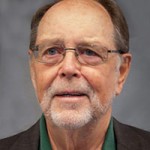 How important are pensions in the larger context? Aside from financial devastation for millions of individual pensioners if they suddenly disappeared, would it matter to our larger state and national economies?
How important are pensions in the larger context? Aside from financial devastation for millions of individual pensioners if they suddenly disappeared, would it matter to our larger state and national economies?
We might ask the National Institute on Retirement Security (NIRS). Founded in 2007 by The Council of Institutional Investors, The National Association of State Retirement Administrators and The National Conference of Public Employees, NIRS lays claim to unbiased, non-partisan analysis and dissemination of their findings to the public, policy makers and the media.
Four years after NIRS’s founding, the National Conference of Public Employee Retirement Systems (NCPERS) also joined NIRS. NCPERS says it oversees 500 retirement plans, managing $3 trillion in retirement funds for seven million retirees and 16 million active public employees across the United States and Canada.
So NIRS just might be able to answer our question. They’ve been analyzing data from the U.S. Census Bureau, the U.S. Congressional Research Service and the U.S. Bureau of Labor Statistics. Their latest report, Pensionomics 2018: Measuring the Economic Impact of DB Pension Expenditures, authored by Research Economist Ilana Boivie, uses 2016 data to examine retirement nationally and within each state. The report’s available on the internet at: https://www.nirsonline.org/wp-content/uploads/2019/01/Pensionomics2018_final.pdf
(Editor’s Note: Some RESDC members may have noticed that this interesting analysis was mentioned in early February in the “News Now” section of our website, as well being posted on the RESDC Twitter feed and Facebook page. It’s important enough to be shared more widely in The NETWORK).
Pensions play large in virtually any economy with a multiplier effect, impacting on at least three levels: “direct benefits” when pensioners buy from retailers, “indirect benefits” when retailers pay their employees and buy more goods, and “induced benefits” when retailers’ employees and suppliers spend their wages and revenues, all measurable events made possible by the original pensions.
Pensions are also more beneficial to the economy than many other financial transactions, we’re told. Due to modest pension levels, retirees must spend quickly, moving the funds through the economy rather than holding reserves. And, because defined benefit pensions are a permanent income source, which cannot be outlived, the beneficial impact on the economy is just as dependable.
So, let’s look at Pensionomics 2018. We reported on NIRS’ Pensionomics 2012 back in 2014, which used 2009 data. It’ll be interesting to see the difference seven years makes.
In 2016, $578 billion in retirement payments went to nearly 27 million Americans, according to the report, an increase of 36% and 42%, respectively, since 2009. Of that, $294.7 billion went to state and local retirees and their beneficiaries, $83 billion to federal retirees and their beneficiaries, and $200.4 billion to private sector retirees and their beneficiaries. Those annual pensions averaged $27,481, $31,281 and $14,800, respectively.
That $578 billion in pensions in 2016 also supported over $1.23 trillion (with a “T”) in overall economic output, and 7.5 million jobs, 4.7% of the national work force. Of that $1.23 trillion, $628.5 billion flowed from state and local pensions, $176.9 from federal pensions and $427.2 billion from private pensions. Economic support in 2009 was $1 trillion.
Ms. Boivie notes that the taxpayer investment factor, from defined benefit pension funds passing through and benefitting the economy, was almost four times that of other transactions. That’s because only 25.14 cents of every dollar paid out in pension benefits in 2016 came from tax funds – the rest from employee contributions and retirement fund earnings. As a result, every taxpayer dollar contributed to state and local pension plans actually supported $8.48 in national economic output. The taxpayer investment factor was $5.52 in 2009.
That’s not all. Value added to the 2016 national Gross Domestic Product by public and private pensions in 2016 was $685 billion, more than that contributed by the entire U.S. national transportation and warehousing industry.
Pensionomics 2018 also reports an estimated $202.6 billion in total tax revenue flowed from public and private pensions in 2016, including taxes paid directly by pension recipients on pension benefits plus taxes on other expenditures in the economy – $86.9 billion of that to states and local agencies and $115.7 billion to the federal government. Those figures, says the report, exceeded all state and local hospital expenditures in 2016, and the $102.7 billion federal defense procurement that year. Taxes flowing from pensions in 2009 totaled $134 billion.
Economic impacts within states are more complicated. Federal and private sector data is limited, for example, and interstate transactions “leak” across state boundaries. But some conclusions can still be drawn.
State economic multipliers averaged $1.41 in 2016. Texas reported the largest, a $1.83 impact for every state and local pension dollar spent, and New Mexico the least, at $1.08. California reported $1.54. State taxpayer investment factors averaged $5.83, maximized in South Dakota at $12.26, and West Virginia the least, at $2.52. California reported $6.53.
California, the largest state economy, showed the largest employment, output and value added impacts, 443,966 jobs, $73.66 billion in output and $44.8 billion in value-added supported by state and local pension expenditures.
Pensions, it seems, remain important to the U.S. economy! (Editor’s Note: Chris Heiserman, RESDC Director, also contributed to this article.) ◾
RESDC Scholarships Helping Students for 23 Years
The Retired Employees of San Diego County (RESDC) have been awarding education scholarships to students related to its members since 1995. The first three $750 scholarships were authorized by the Board of Directors in October 1994; the original criteria for selection were “scholarship record, good character, and good citizenship.”
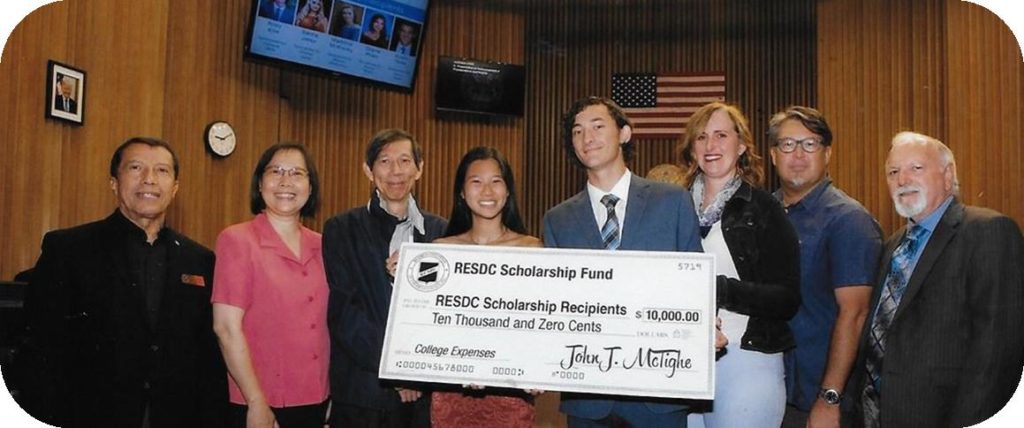
2018 Scholarship recipients with their families at the June Board of Supervisors Meeting.
Current standards for scholarship awards include being of good moral character, and having achieved high personal and academic goals, including sufficient community service to engender pride in himself/herself, the people who recommended them, and to members of RESDC. The merit applications and personal statements are reviewed each year by a selection panel.
George Liddell, a RESDC Board member for many years who also served for 15 years on the SDCERA Board of Retirement, chaired the committee to develop and implement the scholarship program and served as a judge for selecting recipients. He retired from the County Auditor and Controller department in 1976 after 18 years of County service before embarking on his many years of volunteer commitment to retirees. He passed away in 2003.
More than 125 students have received scholarships over the years. They are usually sponsored by their grandparents. Starting in 1998 RESDC awarded three $1,000 scholarships and in 2001 the number of awards was increased to six. Ten students were selected for $1,000 scholarships in 2007, and in 2008 the number of awards was reduced to five and the amount was increased to $2,000. In 2014, a special LaRue Pierce Community Service Award was added to the program honoring a long-serving employee who retired from the Clerk of the Board of Supervisors Office. LaRue was also a long-time RESDC Board member and chaired the Scholarship Committee for many years.
After the scholarships are awarded each year, the student recipients and their sponsors and family members are recognized at a regular meeting of the Board of Supervisors at the County Administration Building. The scholars are then highlighted with photos and background information in a summer edition of The NETWORK.
RESDC is proud to have supported and encouraged these deserving students in pursuit of their educational goals. It represents a special investment in the future and part of our legacy as an organization of enlightened retirees.
We would love to know how some of our past scholarship recipients are doing. We’d like to encourage the sponsors of past recipients to let us know how the students have progressed since receiving scholarship awards from RESDC. You may contact the RESDC office at (619) 688-9229 or email at resdc@resdc.net and give us an update on our successful scholars.
The deadline to submit applications for the 2019 RESDC Scholarhip is Friday, March 1; applications postmarked after this date will not be considered. Final results will be communicated directly to individual participants in the beginning of June. ◾
Recent Events
- Supervisor Dianne Jacob Announces 2019 State of the County Goals. Board Chairwoman Dianne Jacob outlined the County’s 2019 goals at the annual State of the County Address on February 6th at the County Administration Center. Initiatives included improved mental health treatment, affordable housing, and wildfire protection.
- New Study: What Financial Risks do Retirees Face in Late Life? Key Findings:
- As life expectancy rises, more retirees will face late-life financial risks, including: high health costs, financial mistakes due to cognitive decline, and widowhood.
- To date, the research literature suggests that these risks severely affect only a minority of retirees, but the impact may become more widespread in the future.
- The reasons include growing health costs; the rise of 401(k)s, which can be more vulnerable to fraud; and the declining role of Social Security’s widow benefits. To access the study, visit: https://crr.bc.edu/category/briefs/ ◾
Bits and Pieces
Yvonne Pillars celebrated her 80th birthday recently! All her children from various states came to be there for her big day. L. Yvonne retired from Probation in 1999 and moved to Florida in 2000. She and her husband have taken many cross-country drives, one such drive was to all 48 contiguous states. They also enjoy train trips and cruises.
Corinne Wong Miller celebrated her 80th birthday in October by doing one of her favorite things, going on a cruise with her daughter, son-in-law, and her two grandsons.
Iluminada Santos retired from Environmental Health in 2003. She and her husband, Deo, celebrated their 50th wedding anniversary in November! Their children hosted a party for them at Liberty Station. Iluminada and Deo moved to San Jacinto in Riverside County last year.
Jeanie (Virginia) Stewart and her husband, Monty, celebrated their 45th wedding anniversary in November! They took a trip to the upper peninsula of Michigan. Jeanie retired in 2004 from Health and Human Services Welfare Department. She lives in Reedsport, Oregon now. ◾
How to Check Your Credit Score Without Falling for a Scam
This article was submitted by My Senior Health Plan (MSHP). MSHP is a free service that works with individuals to make sure they aren’t paying too much for Medicare health insurance premiums. Call 1 (800) 243-0260 or visit www.myseniorhealthplan.com/crcea to see how much you could save on your premiums!
 In today’s digital age, monitoring your credit is more important than ever, especially for seniors. Due to mounting healthcare costs and living expenses, more and more seniors rely on credit to get by. In fact, senior debt is up by 83% since 2001 (according to data from the Federal Reserve).
In today’s digital age, monitoring your credit is more important than ever, especially for seniors. Due to mounting healthcare costs and living expenses, more and more seniors rely on credit to get by. In fact, senior debt is up by 83% since 2001 (according to data from the Federal Reserve).
You may need to depend on credit at some point in retirement, so it pays to be conscious of your credit score now. Your credit score tells lenders, credit card providers and even assisted living facilities a lot about you and your financial history. Do you pay your bills on time? Are you a responsible borrower?
You need to check your credit score even if you aren’t planning on applying for a line of credit anytime soon because your credit report may also reveal the first indications that you’ve been a victim of identity theft. It can also reveal mistakes that, if aren’t corrected promptly, can affect your credit for years to come.
Scams Are Serious
Because so many American adults depend on credit, there is a wide selection of credit monitoring services to choose from, some legitimate and some fake. While it’s vital to check your credit score, it’s also extremely important to avoid falling for a scam service. You could end up with stolen credit card numbers and leaked personal information – a recipe for identity theft and financial trouble.
Use the following guidelines to ensure you don’t become a victim in your efforts to check your credit score.
Be Wary of Emails and Unsecured Websites
Closely examine any emails you receive regarding your credit score. Visit the website that the email is sent from and verify all links within the email. If you received an unsolicited email, be on your guard. The government does not communicate through email – an official government document will always be sent through the U.S. postal service. Also, never click on downloads or attachments included in the email – it could transmit a virus to your computer.
Never Offer Personal Information
If a website or service asks for your credit card number along with personal information like your address or social security number, do not provide answers. Many of these sites could be scams that plan to steal your identity. Even if they are legitimate, they likely plan to enroll you in a monthly service and charge your credit card for monitoring services that you may not want to pay for, especially if you can receive the information you need for free elsewhere.
Use Verified Resources
You are entitled to three free copies of your credit report each year through the verified website: AnnualCreditReport.com. While these reports don’t show you your actual score, they can help you identify any discrepancies that are necessary to correct in order to keep your score high. If you currently have a credit card, many companies offer free credit monitoring as well, providing you with your FICO score on your monthly statement.
Check your credit score on a regular basis and you’ll feel confident that your personal information is safe and your finances are under control. ◾
RESDC Online Services
 Have you visited the RESDC Member Self-Service website yet? You can login online to:
Have you visited the RESDC Member Self-Service website yet? You can login online to:
- Opt-in to the Member Directory, which is visible only to logged-in members of RESDC. You choose what information to share.
- Register for events and pay online with a credit card.
- View and update your account information such as your email and phone number.
The member self-service area can be accessed by going to www.resdc.net and clicking on the menu item for “Member Login.” You must have an email address on file with RESDC to be able to login. If it’s your first time on the Member Self-Service website, please contact us for assistance setting up your account at (619) 688-9229 or resdc@resdc.net. We’ll send you an email with all the information you need to get started. ◾
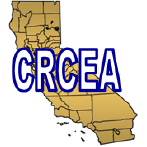 CRCEA Spring 2019 Conference
CRCEA Spring 2019 Conference
Hosted by RESDC
April14-17,2019
ABOUT THE CONFERENCE
California Retired County Employees Association (CRCEA) is a nonprofit coalition of 20 California retired county employee associations, including RESDC. CRCEA provides a forum for educating members and promoting retiree benefits and issues. To further that mission, leadership from these associations meet at semi-annual conferences. The conference is structured to review information relevant to legislation, the state of health care, senior safety, and other issues of importance to retirees.
RESDC is proud to be the host of the CRCEA 2019 Spring Conference, which marks the 50th anniversary of CRCEA. The conference will be April 14-17, 2019 at the Doubletree Hotel Circle in central San Diego.
While the conference is attended by the leadership of the 20 CRCEA counties, we have secured several discounts on activities that are available to both CRCEA conference attendees and RESDC members.
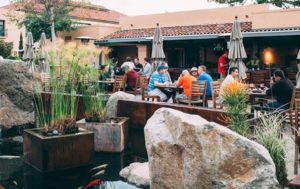 JOIN US FOR A RESDC ROUNDUP!
JOIN US FOR A RESDC ROUNDUP!
“RESDC Roundup” Social Mixer on Sunday, April 14 from 4:00—6:00 p.m. at Stone Brewing in Liberty Station (2816 Historic Decatur Rd, San Diego, 92106). Attendees will get to meet and mingle with retirees from across the state, as well as members of the local association. This is a no-host event. Food and beverages are available for purchase from the restaurant. RSVP requested, but not required: https://www.resdc.net/events#roundup or call (619) 688-9229.
DISCOUNTED ACTIVITIES AVAILABLE TO ALL RESDC MEMBERS
The following discounts must be purchased online directly with the respective organizations.
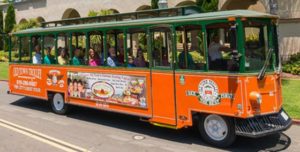 Old Town Trolley Tours
Old Town Trolley Tours
Enjoy a 20% discount off Old Town Trolley Tours, a fun sight-seeing activity! Use code RESDC2019 when purchasing online. Code is valid April 1st – 30th, 2019. Explore the city with a day pass for the hop-on hop-off narrated Tour of San Diego on open-air trolleys, with 10 stops at popular tourist destinations. Or check out the amphibious SEAL Tour to see San Diego by land and by sea. Discount only valid on these two tours, not any packages offered. For more info and to purchase, visit www.trustedtours.net/sdgroups.
 Padres vs. Rockies at Petco Park
Padres vs. Rockies at Petco Park
Enjoy discounted tickets to the Padres game on Monday, April 15 at 7:15pm. Visit www.padres.com/events, scroll down and locate Apr 15 – RESDC April Conference, then click on the green ticket icon. When it asks you to “login,” use pass code RESDC19. Select seats and complete purchase. For transportation and parking information, visit https://www.mlb.com/padres/ballpark/transportation/.
 American Premiere Musical
American Premiere Musical
Life After at The Old Globe
Enjoy a 35% discount to select performances of Life After at The Old Globe in Balboa Park. Britta Johnson’s Life After is a bittersweet, witty, and life-affirming new musical that explores the mess and beauty of loss and love. Discount valid online only, while supplies last. We encourage you to purchase as soon as possible before it sells out. All ticketing service fees are waived. Sales end 2 hours prior to show. No refunds or exchanges. If the ticket price does not say “Group Web 35%” next to it, please do not continue with the transaction. Discounts will not be applied later, all sales are final. Visit the links below to receive the discount for Premium or Section A seating on:
- Saturday, April 13 at 8:00pm
https://www.theoldglobe.org/reserve/index.aspx?performanceNumber=15357&promo=7737 - Wednesday, April 17 at 7:00pm
https://www.theoldglobe.org/reserve/index.aspx?performanceNumber=15335&promo=7737 - Saturday, April 20 at 2:00pm
https://www.theoldglobe.org/reserve/index.aspx?performanceNumber=15349&promo=7737
For driving directions and general info, visit The Old Globe website at https://www.theoldglobe.org or call the Box Office at (619) 234-5623. For assistance ordering, contact the Group Sales Representative, Cristal Salow, directly at (619) 238-0043 x2408. ◾
It’s That Time of Year
March Recruitment Mania
By Chuck Brown, Membership Committee Chair
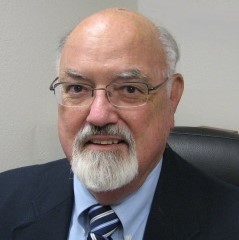 Basketball has March Madness, the USMC “President’s Own” Band has March Mania (there’s a pun in there), and RESDC has March Recruitment Mania! It’s time to show your friends why they should join RESDC. As you might have guessed, the membership recruitment drive is a set of building blocks. This month is really about that old acronym, “What’s In It For Me?” (WIIFM)
Basketball has March Madness, the USMC “President’s Own” Band has March Mania (there’s a pun in there), and RESDC has March Recruitment Mania! It’s time to show your friends why they should join RESDC. As you might have guessed, the membership recruitment drive is a set of building blocks. This month is really about that old acronym, “What’s In It For Me?” (WIIFM)
One of RESDC’s most popular perks is the access to group benefit plans at discounted rates. These benefit plans and discounts are administered by Pacific Group Agencies and are available exclusively to RESDC members. Available plans that are in addition to SDCERA benefit offerings include:
- Dental Insurance – Members have access to two distinct types of dental plans, a PPO and an HMO. Both types are comprehensive and cover procedures including cleanings, X-Rays, fillings, periodontal issues, crowns, dentures, and implants.
- Vision Insurance – Members can choose coverage with exam (VSP) or without exam (materials only) for those who have Kaiser or Health Net medical coverage.
- Hearing Aid Services – Amplifon Hearing Health Care has partnered with RESDC to offer members a free hearing aid discount program, which provides average savings of 62% off manufacturers’ suggested retail prices.
- Travel Insurance –There are two plans. The first plan provides a large cash benefit if you are seriously injured or killed in an accident and the other provides full coverage of medical expenses, trip interruption, emergency travel services, and more.
- Life Insurance – Term Life Insurance policies are designed for people seeking a benefit of $100,000 or more.
- Pet Insurance – Nationwide Pet Insurance offers multiple plans to meet your specific wants and needs.
- Car and Homeowners’ Insurance – As a member, you have access to auto and home insurance tailored to your needs, including homeowner, condo owner, renter, auto, and flood policies
- Legal Services – The Legal Shield program uses a nationwide network of affiliate lawyers who are experienced in dealing with personal and business-related legal issues.
RESDC itself does not provide or administer any of these benefits, nor does RESDC receive any financial compensation for their sale.
Action for March: Contact a fellow retiree or an active employee and tell them the perks of membership and encourage them to join the RESDC family. Share our membership webpage with them or print out the RESDC membership enrollment form to give to your County retiree friends. ◾
Board Member Profile Charles Morgan
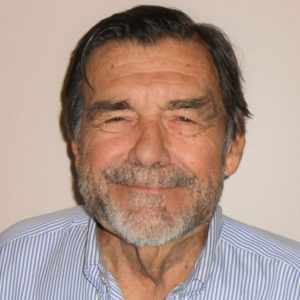 A member of the RESDC Board of Directors since 2018, Charles started working at the County of San Diego in 1966 in the Electronic Data Processing (EDP) department. He wrote applications for many departments using an IBM 360/70 mainframe computer (punch card data). The IBM Personal Computer was introduced in 1981 and he was given the task to manage the installation of Personal Computers for all departments. Their first installation was EDP and the Clerk of the Board. He managed the installation of PC’s until retiring in 1998.
A member of the RESDC Board of Directors since 2018, Charles started working at the County of San Diego in 1966 in the Electronic Data Processing (EDP) department. He wrote applications for many departments using an IBM 360/70 mainframe computer (punch card data). The IBM Personal Computer was introduced in 1981 and he was given the task to manage the installation of Personal Computers for all departments. Their first installation was EDP and the Clerk of the Board. He managed the installation of PC’s until retiring in 1998.
Charles has been married 59 years and has 3 adult children and 3 grandchildren. Most of them live close by. He and his wife often travel abroad and throughout the United States, as well as Mexico, including Baja California. He and his family are very involved with animal welfare and rescue, and have founded and direct a beagle club that rescues and fosters beagles. ◾
Pension Facts At a Glance
78.4%
Funded ratio of SDCERA Retirement Fund increased from 77.4% to 78.4% from FY2016-17 to FY2017-18. ◾
Members Share
My New Zealand Experience
By Marilyn LaStrape, Health and Human Services, Retired 2002
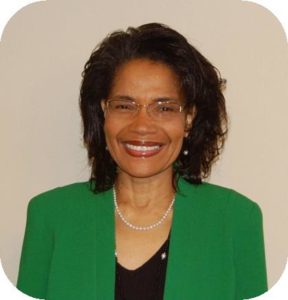 My trip to New Zealand was the result of the native missionary of this island nation visiting the congregations in the states who financially support his work. Prior to the fellowship meal following worship he said, “Marilyn, you need to come and be our special guest speaker at the Ladies’ Challenge next year.” My trip was October 23-31, 2017. The ladies were celebrating the 21st year of this event. The preparations made and their hospitality from the time I arrived until I departed was outstanding!
My trip to New Zealand was the result of the native missionary of this island nation visiting the congregations in the states who financially support his work. Prior to the fellowship meal following worship he said, “Marilyn, you need to come and be our special guest speaker at the Ladies’ Challenge next year.” My trip was October 23-31, 2017. The ladies were celebrating the 21st year of this event. The preparations made and their hospitality from the time I arrived until I departed was outstanding!
The coordinator of the ladies’ program who booked my flight told me I would need to be there at least a week. She said, “When your plane leaves the states that Monday, it will be Wednesday when you get here. You will need to have a little time to recoup from the flight – New Zealand is 18 hours ahead of the time in Texas.” This was my first international flight. I was not prepared for the shock to my body.
The connection between LAX and Auckland was the most crucial link which was 13 hours long! Once I arrived, the common questions were, “Where are you from?” and “Where is Texas?” Most people knew where America was, but not Texas! Upon my return home the main question was, “What was it like?” My reply was, “It was like running in a 26-mile marathon when you had never run around the block!” The total flight time was 21 hours. I slept for two days when I got home.
The cultural differences in food and drink took some adaptation. Ice is not served in restaurants and there is no ice in home refrigerators. Every time I was introduced to a new food or drink, or a creation in nature that was different to me, I found myself saying, “Only God could do that.” The prices for everything were double/triple. One muffin at the Auckland airport was $6.00! I was very thankful for my host taking care of the money exchange requirements. I spent nothing.
In that part of the world, water swirls counterclockwise. I asked my host was that because of engineering. He said, “No, it’s the gravitational pull.” Spring is September to November; in October 2017, it was mostly cold, windy, and rainy which virtually halted all site seeing plans. They all speak English but with the Australian accent, which I found most challenging at times to understand. With their cars built with the steering wheel on the right, and driving on the left-hand side of the road, being a first-time passenger was most unnerving! There were only two lanes for traffic in each direction and the drivers had their foot in the gas tank. In some areas, there was no place to leave the freeway if something happened, but I remained as calm as possible.
Round trip was approximately 16,800 miles from my home. When New Zealand’s exact location in God’s world began to really sink into my brain, I was truly overwhelmed! One lady told me, “Any further west you go from here – the next land you will see is Hawaii.” God is in control of all parts of His world. It was truly a once-in-a-lifetime experience!
Editor’s Note: If you have a favorite or unusual travel experience you would like to share, please send it via email to resdc@resdc.net or mail it to RESDC, 8825 Aero Dr., Suite 205, San Diego, CA 92123. You can also call the RESDC office with any questions at (619) 688-9229. ◾
Welcome New Members
Renee A. Beverly-Archangel – Child Welfare Services
David F. Bitonti – Sheriff
Jay W. Browder – Superior Court
Casimir A. Derengowski – Probation
Barbara J. Farran – District Attorney
Kenneth J. Holland – Superior Court
Patricia S. Hoyt – Child Welfare Services
Daisy A. Mayers – Child Support Services
Douglas P. Mooney – District Attorney
Tracy M. Sandoval* – Finance & Gen. Govt.
Maria N. Tubbs-Petrocco – Child Support Services
*Associate Member
The surviving Spouse of a member is eligible for RESDC membership. For enrollment assistance, please call: (866) 688-9229. ◾
NETWORK is the official monthly newsletter of the Retired Employees of San Diego County, Inc. (RESDC), a private non-profit organization.
The information printed in the NETWORK is believed to be from reliable sources. However, no responsibility is assumed by the NETWORK for inaccuracies contained herein.
Business and Inquiries: Business matters and address changes may be recorded on our voicemail at any time, call (866) 688-9229. Please spell your name so the correct member record can be located.
Retired Employees of San Diego County, Inc.
8825 Aero Drive, Suite 205 | San Diego, CA 92123
Office Hours: 9 a.m. to 2 p.m. Monday through Friday
TELEPHONE: (866) 688-9229 Toll Free
FAX: (619) 688-0766
E-MAIL: resdc@resdc.net

